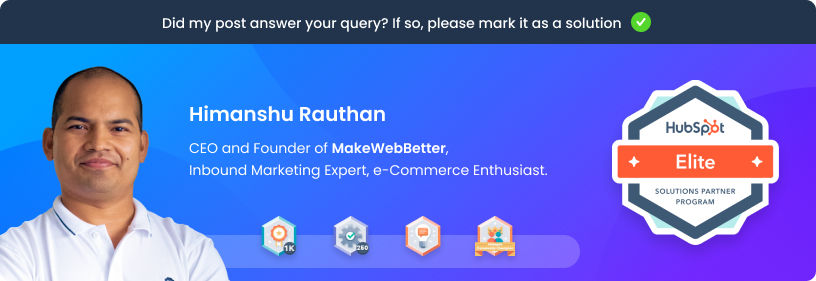- HubSpot Community
- CRM & Sales Hub
- CRM
- Re: HubSpot Data Model / Filter on associated objects / Activation with lists or workflows
CRM
- Subscribe to RSS Feed
- Mark Topic as New
- Mark Topic as Read
- Float this Topic for Current User
- Bookmark
- Subscribe
- Mute
- Printer Friendly Page
Feb 23, 2021 11:57 AM - edited Feb 23, 2021 12:01 PM
HubSpot Data Model / Filter on associated objects / Activation with lists or workflows
SOLVEHi team,
I hope you are all doing well and thanks to read my post! 🤗
I work for an actor of the nursery and I'm going to tell you my issue:
I need to have a contact database that contains parents and children. The parent has the main email address (that's who I want to talk to) but the child has the main information (what type of program is being followed, how old is he or she...).
Hypothesis 1:
With a custom object: Create a child custom object and Use contacts as parents.
Problem: I can't create lists or workflows based on children which select the associated parents.
Hypothesis 2:
Without custom object: One contact = one child.
Problem: I am going to have children who have the same email address several times (because a parent can have several children). But I don't want to send several times an email to the same person
Hypothesis 3:
Without custom object: One contact = one parent and I use custom properties to insert information about the child
Problem: I duplicate as many columns as there are children, lack of readability.
Do you have convictions about my different hypotheses, do you have good ideas if you use a similar model in production?
Thank you in advance for your answers, see you soon.
Solved! Go to Solution.
- Mark as New
- Bookmark
- Subscribe
- Mute
- Subscribe to RSS Feed
- Permalink
- Report Inappropriate Content
Feb 24, 2021 9:16 AM
HubSpot Data Model / Filter on associated objects / Activation with lists or workflows
SOLVEHi @LPorcher,
So what you can do is make use of Custom Object. What you have to do is create one custom object say Children and along with the set up of this custom object you can set primary properties in this object say, for example, ‘Roll Number’ of Children instead of ‘Email-Id’. Now finally, you have to associate the Children objects with the Contact as Parent.
Now for creating the report you need to perform the following steps:
- First, create one custom property in the custom object which is relating child to parents like parent email id or parent unique no. or anything similar.
- Create a contact-based workflow and choose the custom object in the trigger (as shown in the screenshot). Below I had linked my custom object (School-vendor) with the company so. Therefore, I created a company-based workflow. But things will be similar with the contact-based workflow as well and then in action set custom object property with contact token.
- Lastly, you need to create a custom report of a single object which is your custom object and create your consolidated report on the basis of that custom property value you copied in the second step.
I hope this will solve your query.
Regards,

- Mark as New
- Bookmark
- Subscribe
- Mute
- Subscribe to RSS Feed
- Permalink
- Report Inappropriate Content
Feb 25, 2021 9:58 AM
HubSpot Data Model / Filter on associated objects / Activation with lists or workflows
SOLVEOkay, I found where the issue is. We can use an alternative method for creating the report. I tried making a custom object in my portal with the name children that are having unique property Roll No. then I created some test children. Lastly, I visited the report section in HubSpot where I chose the beta option of reports.
Finally, I selected properties from both objects and create this report.
I hope this will help you. Do let me know the status.
Best Regards,

- Mark as New
- Bookmark
- Subscribe
- Mute
- Subscribe to RSS Feed
- Permalink
- Report Inappropriate Content
Feb 25, 2021 5:37 PM
HubSpot Data Model / Filter on associated objects / Activation with lists or workflows
SOLVEHi @LPorcher,
Hoping I can shed a little light here. You're correct in that currently you cannot use Custom Object based criteria as enrollment for Lists. I say currently as the Custom Objects are still a new feature and HubSpot are constantly improving and updating.
That said, dependent on your exact use case, not being able to do so is not always as big a hindrance as it may seem.
For example, we had a client in much the same situation, needing to store information on multiple children and be able to send relevant emails based on that data to the parent.
This was prior to Custom Objects, so we actually used Deals to represent Children and Contacts to represent Parents. When we needed to send specific information about the Child, we would trigger an email from a DEAL based workflow which would allow us to use Deal Tokens in the Marketing Email, but the email would be sent to all associated contacts (in this case, just the one).
Now. If you wanted to get SUPER technical, you could create workflows that would copy that information from the Custom Object to the Parent Contact following the below:
Workflows:
Child create date is less than one day ago
IF At least one associated Contact "Child 1 Name" is unknown
YES BRANCH - Copy Child "Name" to Contact "Child 1 Name"
NO BRANCH - IF At least one associated Contact "Child 2 Name" is unknown
And so on and so forth up to an max number of children you decide.
Hopefully that answered more questions than it raised!
- Mark as New
- Bookmark
- Subscribe
- Mute
- Subscribe to RSS Feed
- Permalink
- Report Inappropriate Content
Feb 25, 2021 5:37 PM
HubSpot Data Model / Filter on associated objects / Activation with lists or workflows
SOLVEHi @LPorcher,
Hoping I can shed a little light here. You're correct in that currently you cannot use Custom Object based criteria as enrollment for Lists. I say currently as the Custom Objects are still a new feature and HubSpot are constantly improving and updating.
That said, dependent on your exact use case, not being able to do so is not always as big a hindrance as it may seem.
For example, we had a client in much the same situation, needing to store information on multiple children and be able to send relevant emails based on that data to the parent.
This was prior to Custom Objects, so we actually used Deals to represent Children and Contacts to represent Parents. When we needed to send specific information about the Child, we would trigger an email from a DEAL based workflow which would allow us to use Deal Tokens in the Marketing Email, but the email would be sent to all associated contacts (in this case, just the one).
Now. If you wanted to get SUPER technical, you could create workflows that would copy that information from the Custom Object to the Parent Contact following the below:
Workflows:
Child create date is less than one day ago
IF At least one associated Contact "Child 1 Name" is unknown
YES BRANCH - Copy Child "Name" to Contact "Child 1 Name"
NO BRANCH - IF At least one associated Contact "Child 2 Name" is unknown
And so on and so forth up to an max number of children you decide.
Hopefully that answered more questions than it raised!
- Mark as New
- Bookmark
- Subscribe
- Mute
- Subscribe to RSS Feed
- Permalink
- Report Inappropriate Content
Feb 24, 2021 10:54 AM - edited Feb 25, 2021 3:36 AM
HubSpot Data Model / Filter on associated objects / Activation with lists or workflows
SOLVEThank you, thank you and thank you again for these details.🤗
So hypothesis 1 is the most relevant!
I managed to create a workflow based on the Child custom object, and to see the parents associated.
However, I can't create a workflow based on contacts (parents) and filter on the child custom object. (in the opposite direction) Do You confirm me that it is not possible in this direction?
Same thing, I can't create lists based on cross objects: filter on the child AND the parent. Do you have any idea of how to do this?
- Mark as New
- Bookmark
- Subscribe
- Mute
- Subscribe to RSS Feed
- Permalink
- Report Inappropriate Content
Feb 25, 2021 9:58 AM
HubSpot Data Model / Filter on associated objects / Activation with lists or workflows
SOLVEOkay, I found where the issue is. We can use an alternative method for creating the report. I tried making a custom object in my portal with the name children that are having unique property Roll No. then I created some test children. Lastly, I visited the report section in HubSpot where I chose the beta option of reports.
Finally, I selected properties from both objects and create this report.
I hope this will help you. Do let me know the status.
Best Regards,

- Mark as New
- Bookmark
- Subscribe
- Mute
- Subscribe to RSS Feed
- Permalink
- Report Inappropriate Content
Feb 24, 2021 9:16 AM
HubSpot Data Model / Filter on associated objects / Activation with lists or workflows
SOLVEHi @LPorcher,
So what you can do is make use of Custom Object. What you have to do is create one custom object say Children and along with the set up of this custom object you can set primary properties in this object say, for example, ‘Roll Number’ of Children instead of ‘Email-Id’. Now finally, you have to associate the Children objects with the Contact as Parent.
Now for creating the report you need to perform the following steps:
- First, create one custom property in the custom object which is relating child to parents like parent email id or parent unique no. or anything similar.
- Create a contact-based workflow and choose the custom object in the trigger (as shown in the screenshot). Below I had linked my custom object (School-vendor) with the company so. Therefore, I created a company-based workflow. But things will be similar with the contact-based workflow as well and then in action set custom object property with contact token.
- Lastly, you need to create a custom report of a single object which is your custom object and create your consolidated report on the basis of that custom property value you copied in the second step.
I hope this will solve your query.
Regards,

- Mark as New
- Bookmark
- Subscribe
- Mute
- Subscribe to RSS Feed
- Permalink
- Report Inappropriate Content
Feb 24, 2021 5:15 AM
HubSpot Data Model / Filter on associated objects / Activation with lists or workflows
SOLVEHi @LPorcher
Thank you for reaching out and for the detailed post! 🙂
I want to tag some of our experts to see what they think! @Bruno_Teixeira @NicoleSengers @rikkilear do you have any thoughts for @LPorcher on this?
Thank you!
Best
Tiphaine
 | Saviez vous que la Communauté est disponible en français? Rejoignez les discussions francophones en changeant votre langue dans les paramètres ! Did you know that the Community is available in other languages? Join regional conversations by changing your language settings ! |
- Mark as New
- Bookmark
- Subscribe
- Mute
- Subscribe to RSS Feed
- Permalink
- Report Inappropriate Content




